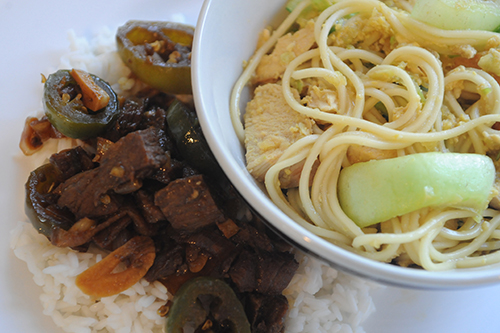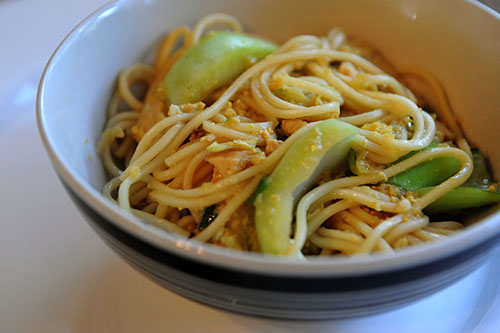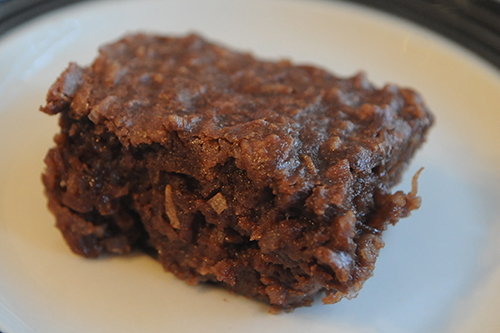 |
But alas, I don't have that option so I have to settle with guessing. Usually it turns out great, though I never really know if I got it right.
This week we're doing Indonesia, or more specifically, Java and Madura, Indonesia. These two volcanic Islands are often grouped together but Java is the larger one--in fact it's actually the 13th largest island in the world by land mass and the world's most populous island. Java is 53,589 square miles but there are 143 million people living there--that's roughly the same number of people living in Russia's entire 6,592,800 square miles. So Java is also one of the most densely populated places in the world.
 |
| Photo by Trey Ratcliff. |
Javanese food differs from other Indonesian cuisines primarily by how much sweeter it tends to be. Javanese food often contains palm sugar or kecap manis, which is a sweet soy sauce (we used it back in the Ashmore and Cartier Islands, way back in the A's). Most Javanese food is simple and doesn't tend to be very spicy, though one of the dishes I made this week certainly was.
| Java is the red island; Madura is that little gray finger off the North Eastern Coast. |
The first recipe came from a website called Pig Pig's Corner. This site is actually run by a Malaysian blogger, but this recipe was a guest post from a blogger from Indonesia Eats, which is incidentally the place where I got my other two recipes. Anyway here's that first one:
Lombok Kethok
- 3 tbsp oil coconut oil
- 4 decent-sized shallots
- 3 cloves garlic
- 9 oz beef brisket
- 4 tbsp kecap manis
- 10 jalapeno peppers
- 1 1/2-inch piece galangal, halved and bruised
- 3 Indonesian bay leaves
- 1 stalk lemongrass (white part only), halved and bruised
- 1/2 cup reserved beef broth
- Sea salt to taste
Bakmi Godhog
For the spice paste:
- 3 decent-sized shallots
- 4 garlics cloves
- 5 candlenuts (substitute macadamia nuts)
- 1 tbsp sea salt
- 1 2/3 lb bone-in chicken
- 1 inch piece of ginger, scrapped and bruised
- 4 stalks Chinese garlic (substitute sprouted garlic)
- 1 oz Chinese celery
- 9 1/2 cups water
- 10 1/2 oz fresh cooked Chinese noodle s
- 2 eggs, lightly beaten
- 2 tbsp kecap manis
- 4 1/2 oz cabbage, shredded
- 4 1/2 oz bok choy, cut into 1 inch pieces
- 3 green onions, sliced
- 1 oz Chinese celery, chopped
Javanese Coconut Sticky Rice Cake
- 1 1/2 cups glutinous rice (sticky rice) flour
- 1 3/4 cups medium coconut milk
- 1 tsp vanilla extract
- 1 1/3 cup raw cane sugar
- 1/4 tsp kosher salt
- 2 1/2 cups grated coconuts
- 3/4 oz 90% dark chocolate
- 1/4 cup cocoa powder
- banana leaves
Boil the brisket with a half stalk of lemongrass, half the galangal and one Indonesian bay leaf until just tender, taking care not to over-cook it the way I did. Drain, but reserve a half cup of the broth for later.
Now cut the beef up into cubes or slices (I cut mine into small cubes in the hope that no one would notice how overcooked it was) and set aside. Heat the oil and fry the shallots until fragrant, then add the beef pieces, kecap manis and beef broth. Stir to mix and then add the other half of your lemongrass stalk, the rest of the galangal, the rest of the bay leaves and all of the chiles.
 |
 |
Meanwhile, put all the spice paste ingredients together in a food processor or mortar and pestle. Process until smooth.
Your noodles should already be cooked, so prepare some warm water and then transfer the noodles to that pot for about one minute. Drain well.
Now take the chicken pieces and put them under your broiler. Let them broil until blackened, then remove from the bone and shred or cube the meat.
Heat 3 tbsp of oil and fry the spices until they start to turn brown, which should take between five and seven minutes.
 |
 |
Preheat your oven to 350 degrees. Layer a 9x9 pan with banana leaves (if you don't have any, just grease the pan. I promise they'll be fine).
Now heat the coconut milk over medium heat. Add the vanilla extract and sugar and stir until melted, then add the salt, the dark chocolate and the cocoa powder. Whisk until everything is melted and blended together.
 |
Note: these things slice much easier if you refrigerate them before serving.
 |
I liked the noodles, too, but my eggs curdled so they were actually very unpleasant to look at, though tasty. I think if I made this again I would add the eggs after taking the dish off of the heat, the way I did it back in Bolivia. For that I might actually use pasteurized eggs though, because past experience has made me kind of chicken about eating anything that might potentially contain undercooked eggs.
Now for the dessert--it was very sticky and very different. My kids said they liked it, then they said they didn't like it, so they were clearly confused. Martin ate a lot of them. I ate one or two. I'm not sure I ever decided what I thought about them--they were good, but I'm an American so really I would rather just have a brownie.
Next week: Jersey











0 comments:
Post a Comment